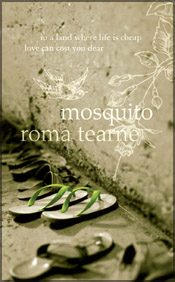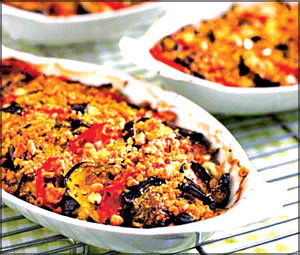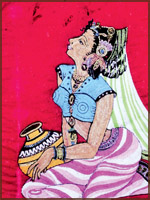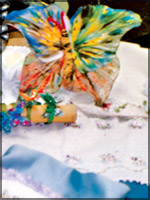|

‘Painting’ with words to bring Lanka to life
Roma Tearne shortlisted for Costa First Novel Award:
|

Roma Tearne |
When Christopher Ondaatje calls your debut novel ‘heart-rending’ you
know you are on to something big. The Costa First Novel Award, no less.
Sri Lankan painter and writer Roma Tearne’s powerful new novel
Mosquito has been shortlisted for the prestigious Costa Prize, second
only to the Man Booker. The winners will be announced shortly.
Roma may have left Sri Lanka at 10, but the country is portrayed
vividly in her critically-acclaimed novel. Her second novel, Bone China,
also set in Sri Lanka, will be out in April 2008.
“Every writer’s dream is to be short-listed for a literary prize.
Last week I was short-listed for a first novel award, but far from a
dream, I would say it was more like a nightmare. Until the moment I
heard about the prize I had been writing the third draft on my next
book.
I had been working since September, rising early, writing until
midday, walking along the Tow-path after lunch, then working again in
the afternoon, pairing down and polishing sentences as though they were
precious stones.
I was now only three chapters from completion. But from that morning,
hearing of the shortlist, I could not settle,” Roma writes in her
widely-followed blog.
“I am a writer who is happiest only when I am working on my next
book, grappling with my characters, breathing life into them. What I
want, more than anything in the world, is to be able to continue to
write. Indeed, I now see, existence itself is impossible were I not able
to do so,” Roma says.
Roma’s life story is one of courage and determination. She is a
multi-faceted personality, also having a reputation as an excellent
painter. She gained her Master’s degree at the Ruskin School of Drawing
and Fine Art, Oxford, and was Leverhulme Artist in Residence at the
Ashmolean Museum, Oxford.
In 1998, the Royal Academy of Arts, London, highlighted one of her
paintings, Watching the Procession, for its Summer Exhibition.
As a result her work became more widely known and was included in the
South Asian Arts Festival at the Ikon Gallery, Birmingham in 1992. In
1993, Cadogan Contemporaries, London, began showing her paintings, then
in 2000, the Arts Council of England funded a touring exhibition of her
work.
Entitled ‘The House of Small Things’, this exhibition consisted of
paintings and photographs based on
|

One of her paintings |
childhood memories.
They were the start of what was to become a preoccupation with issues
of loss and migration. She was recently awarded a fellowship in the
visual arts by the Arts and Humanities Research Council of Great
Britain.
For nearly 20 years her work as a painter, installation artist and
filmmaker has dealt with the traces of history and memory within public
and private spaces. She lives and works in Oxford.
In the meantime, Mosquito continues to earn accolades.
“Tearne brings her skills as a painter to her writing, creating some
extraordinarily lovely portraits of Sri Lankan land and seascapes, a
stunning backdrop to the changing horrors of the country’s 20-year war.
Anyone who has visited, or has a passing interest in Sri Lanka, should
read this beautiful novel,” wrote the Sunday Telegraph reviewer.
“Mosquito plays with sensuous mixes of human bestiality and natural
beauty...It is in this continuing agency of remembered love - presented
as the colours, sounds and smells of art, in dialogue with beauty and
horror - that the uplifting politics of this fine novel lies,” said the
Independent. And as Ondaatje told the Spectator, the book is also about
hope, which Roma herself thrives on.
Courtesy: Harper Perennial
**********************
Mosquito: The sting is in the words
 After
writer Theo Samarajeeva loses his wife, he moves from England back to
his home in Sri Lanka. Just as his grief threatens to undo Theo, Nulani
Mendis - a young artist - arrives on his veranda, and begins to draw
him. After
writer Theo Samarajeeva loses his wife, he moves from England back to
his home in Sri Lanka. Just as his grief threatens to undo Theo, Nulani
Mendis - a young artist - arrives on his veranda, and begins to draw
him.
After a time, Nulani’s presence starts to heal Theo, and their
friendship blossoms into something more. But the conflict in Sri Lanka
steps in and interferes. But all too soon, the violence that casts an
ominous shadow over their love explodes. No-one, it seems, is safe; only
the sea and the land remain breathtakingly lovely.
The reader is drawn further into the story, wondering how Nulani and
Theo’s newfound relationship could possibly survive. Ultimately, each of
them will be tested in the most terrible ways...
Henna
Nature’s gift to sprinkle colour:
Sachitra Kalubowila
Among herbals, henna is much popular and considered a wonderful gift
of nature.
It comes from the dried leaves of Lawsonia inermis and called
“Mehendi” in India, “Marathondi” in Sri Lanka, “Madayantika” in Sanskrit. Its active ingredient lawsone is one of the
nature’s richest sources of colour.
“Madayantika” in Sanskrit. Its active ingredient lawsone is one of the
nature’s richest sources of colour.
Henna also acts as a cultural symbol in India. Before a wedding, the
bride’s palms and soles are decorated in designs with henna paste. In
some regions the bridegroom’s palms are stained with henna to symbolise
the deep love between the husband and wife. Cleopatra was said to have
anointed her hair and palm with henna before bathing in the river Nile.
Medicinal use
The original colour of natural henna is yellowish green. In Ayurvedic
medicine it is considered an anti irritant agent to heat rashes, skin
allergies and also as a body cooling agent.
How it works on your hair
Natural henna works differently depending on the gray/black ratio of
the hair. It imparts dark- reddish brown color to the gray hair and a
beautiful natural reddish color to the black hair with repeated
application.
It’s a very good treatment for those seeking the gray coverage at the
early stage. According to experienced professional hairdressers this works well when the gray hair percentage
does not exceed 20 per cent of the total hair. If you are a beginner it
is always prudent to use natural herbal henna since it does not contain
any chemical ingredients.
professional hairdressers this works well when the gray hair percentage
does not exceed 20 per cent of the total hair. If you are a beginner it
is always prudent to use natural herbal henna since it does not contain
any chemical ingredients.
But if the percentage of gray hair exceeds 20 per cent of the total
hair or the hair is bleached or highlighted, the resultant colour given
by henna will be orange. Henna products mixed with a small percentage of
chemicals in the market are called black henna or treated henna.
How to apply
Make a smooth henna paste with hot water. Adding 2-3 drops of lime
juice will make the red colour brighter on your hair. Mixing with beet
root and hibiscus extract create lovely deep burgundy shades that can
add deep reddish highlight on black hair. This is very trendy these
days.
If the purpose is to cover the gray hair, it is better to mix with
strong tea or coffee which result dark brown rater than red.
The mixture should be thoroughly applied to hair and cover the head
with a polythene cap or shower cap to accelerate the reaction and to
prevent the paste from dripping. Leave for 30- 45 minutes to develop the
colour. Finally rinse the hair well with warm water.
The paste should not be kept for another application. You can easily
prepare this pack at home.
(Store natural henna powder in a cool and dry place to avoid getting
damp.)
As a natural conditioning agent
To use as a conditioning pack mix the henna paste with curd or
yoghurt. (But the addition of more conditioning agents may results less
intensive colour)
As a protein pack
Add an egg white to the conditioning pack. It nourishes the hair and
scalp rather than giving the colour.
The regular use of these mixtures prevents dandruff.
After care treatment
Henna shampoo and henna conditioners in the market help increase the
tone of the colour and reduce the rate of colour fading .
As henna makes a thick coating around the hair fibres it acts as a
barrier to other chemical treatments such as permanent dyes, perming and
straightening. If you wish to apply any chemical treatment, wait at
least 2-3 months to remove the henna coating.
To choose good quality henna powder, look for the colour of the
powder. It has to be yellowish green. Sometimes you may find henna
powder in dark/bright green. It contains some artificial ingredients.
Eggplant in Mustard Sauce
Country -Bangladesh

Ingredients
- 1 large Eggplant
- 3 tbsp Mustard seeds
- 8 Green Chili
- 14 stalks Cilantro (corriander)
- Salt to taste
- 5 tbsp cooking oil
- 1 Tsp turmeric powder
- 0.5 cup water
- 1 Tsp sugar
Instructions
1. Slice eggplant into 1/2 inch thick pieces that look like half
moons.
2. Rub some turmeric powder, salt and sugar on the eggplant pieces
and set aside.
3. Grind mustard seeds along with four green chilies, ten stalks of
cilantro and salt to fine paste in a blender, adding half a cup of
water. This will take up to five minutes depending on the power setting
on your blender.
4. Heat oil in a frying pan and fry eggplant pieces to light brown.
5. Strain the ground mustard paste, adding directly to the fried
eggplant. At the same time add four sliced green chilies and bring to a
boil. Reduce heat and simmer for about eight to 10 minutes.
6. Garnish with some chopped cilantro and serve hot with chapattis,
parathas or rice.
Punch embroidery - Clement’s Way
 Punch
embroidery Clements Way - embroidery exhibition displaying different
kinds of new designs for blouses, table cloth, cushion covers,
wall-hangings and dresses has been organised. Punch
embroidery Clements Way - embroidery exhibition displaying different
kinds of new designs for blouses, table cloth, cushion covers,
wall-hangings and dresses has been organised.
The exhibition will be held on November 30 and December 1 - Negombo
Bertha Association, December 2 - Chilaw Sudasuna Hall, December 6 -
Galle Co-operative Building, December 15 and 16 - Kandy Sampath
Reception Hall from 9 a.m. - 6 p.m.
Miracle Wings
 Hilda
Herat, Nelum Munasinghe, Sherine Munasinghe and seven other women will
hold Miracle Wings - their annual exhibition of household linen,
artificial floral arrangements, cakes, wines, plants and many handicraft
items on December 1 at the All Ceylon Women’s Buddhist Congress from 9
a.m. to 6 p.m. Shadow embroidery, embroidery done on the reverse side of
the cloth will be a special attraction. Hilda
Herat, Nelum Munasinghe, Sherine Munasinghe and seven other women will
hold Miracle Wings - their annual exhibition of household linen,
artificial floral arrangements, cakes, wines, plants and many handicraft
items on December 1 at the All Ceylon Women’s Buddhist Congress from 9
a.m. to 6 p.m. Shadow embroidery, embroidery done on the reverse side of
the cloth will be a special attraction.
Cottage craft, embroidered kurtas and sarees will be the special
attractions this time. Food stalls and a variety of pickles and sweets
will also be part of the event.
Handicrafts sale
Sarath Malalasekera
 The
Lanka Mahila Samithi held its annual sale of handicrafts at the Girls’
Friendly Society, Kollupitiya, on Tuesday. The Canadian High
Commissioner in Sri Lanka Angela Bogdon was the chief guest. The
Lanka Mahila Samithi held its annual sale of handicrafts at the Girls’
Friendly Society, Kollupitiya, on Tuesday. The Canadian High
Commissioner in Sri Lanka Angela Bogdon was the chief guest.
A variety of attractive handicrafts produced by members of the Rural
Mahila Samithi in several districts were on sale.
Fine crochet and beeralu lace, table cloth and teapoy covers, as well
as cushions with traditional Sinhala embroidery were brought from the
South. The Kalutara district Samithi sent in sleeping mats, sewing
boxes, wallets, coasters and other products.
Baskets of various types and sizes, table mats and other household
articles made of rush, reed ekel and cane from Kegalle and other
districts arrived whereas wall hangings, wallets and letter holders from
Kandy also graced the event.
Another attraction was smocked children’s frocks, night dresses and
baby dresses from Bulathsinhala. There was a variety of Batik items
including kaftans, shirts, sarongs, wall hangings and table cloth with
napkins to match. |

